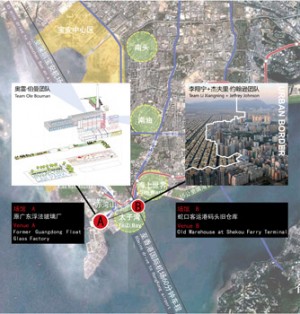2013 Bi-City Biennale of Urbanism\Architecture (Shenzhen) – “UABB(SZ)”
December 6, 2013 – February 28, 2014
Team Ole Bouman is responsible for Venue A, the former Guangdong Float Glass Factory. This abandoned factory will be transformed into a cultural hotspot within the framework of “Urban Border.” Team Li Xiangning + Jeffrey Johnson is responsible for Venue B, a post-industrial warehouse adjacent to the Shekou Ferry Terminal. The team will explore the boundary of the contemporary city from a historical perspective. Both locations will be connected by a greenway curated by Team Ole Bouman.
The Glass Factory, once the cradle of industrial modernization in this Special Economic Zone, will soon become a new production facility—this time producing beauty, ideas and new value for Shenzhen. This shift will turn the factory into the main protagonist of the Biennale, making the building no longer the background of the exhibition, but making it the foreground of the event itself.
The Creative Director Ole Bouman and his team invited a dozen emerging international architects to Shenzhen to transform the factory into a cultural hotspot. Architects came from all over the world: from China to The Netherlands, from Finland to Serbia, from India to Brazil. Well known firms with a global portfolio teamed up with small boutique firms.
As the design phase for the factory moves on to the next stage, Team Ole Bouman has committed a variety of local and international organizations to choose UABB(SZ) as a temporary mode of operation and address.
Li Xiangning and Jeffrey Johnson, the Curators, Academic Directors, propose to reassert the importance of knowledge and history in architectural and urban design discourse, with UABB(SZ) at the center of this global conversation. With the theme “Urban Border,” they will explore the city and its transformations through the lens of borders, boundaries and edges—conditions that extend beyond the physical to those delineated by nonphysical and ephemeral forces, including sociological, political, economic and environmental. As articulated in Chinese, the compound word Bian Yuan (boundary) represents the concept of border, which does not merely mean physical border, but the differences among diversified subcultures and distinctive identities. By splitting the word Bian Yuan (boundary) into two individual characters, the team will emphasize the meaning of relationship, connection and opportunity (Yuan), instead of differentiation (Bian).
A multi-disciplinary group of participants will be invited to develop a critical perspective on the conditions of urban boundaries as they mutate and transform with multiple morphological and ideological shifts. By revealing these transformations, a future “border” condition can be imagined that will stimulate creative and innovative experimentation.


